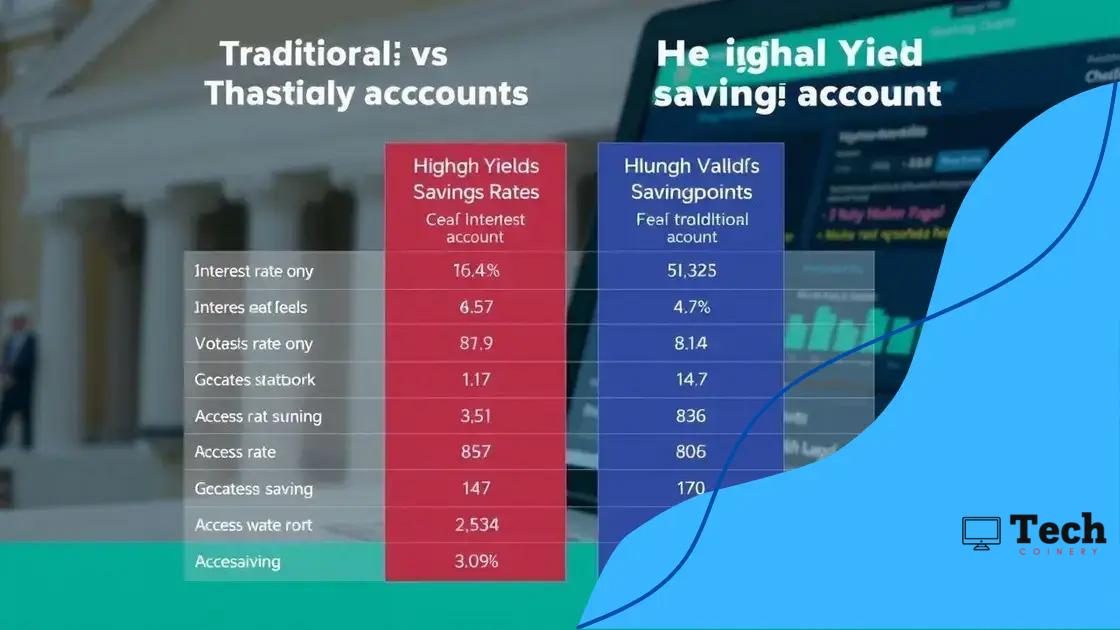High-yield savings trends 2025: what to expect

High-yield savings trends for 2025 indicate that consumers can benefit from significantly better interest rates, reduced fees, and a focus on digital banking, making these accounts a smart choice for maximizing savings.
High-yield savings trends 2025 promise to change the way we think about savings. Are you ready to capitalize on these evolutions that can enhance your financial strategy? Let’s dive into what’s ahead!
Understanding high-yield savings accounts
Understanding high-yield savings accounts is essential for anyone looking to maximize their savings potential. These accounts offer better interest rates compared to traditional savings accounts, making them a smart choice for your financial health.
A high-yield savings account is designed to help you grow your money faster. Unlike standard savings accounts, they often have higher annual percentage yields (APYs), enabling you to earn more interest over time. However, it’s important to know how these accounts work and what to consider before opening one.
Key Features of High-yield Savings Accounts
High-yield accounts typically have a few features that set them apart:
- Higher Interest Rates: They usually provide interest rates that are several times higher than traditional accounts.
- No Monthly Fees: Most high-yield savings accounts come without monthly maintenance fees.
- Access to Funds: While these accounts allow you to earn interest, they also provide easy access to your money, often with online banking options.
When choosing a high-yield savings account, it is crucial to consider factors like the bank’s reputation and the ease of online access. Some accounts require a minimum balance to earn the advertised interest rate. Make sure to evaluate these aspects to get the most benefit.
Why Choose a High-yield Savings Account?
Many people choose high-yield savings accounts because they want to save for goals like buying a house, a vacation, or an emergency fund. The additional interest can make a significant difference over time.
Another reason these accounts are popular is their safety. Typically, funds in high-yield savings accounts are insured by the FDIC up to a certain limit, protecting your money.
Ultimately, a high-yield savings account can boost your savings strategy. With a bit of research, you can find the right account that fits your needs and helps you achieve your financial goals.
Key trends shaping savings interest rates
Key trends shaping savings interest rates are crucial to understanding how your money can grow. Interest rates on savings accounts can change due to various factors, and knowing these can help you make informed decisions.
One major trend is the overall economic environment. For example, when the economy is booming, interest rates may rise as banks compete for deposits. Conversely, during economic downturns, rates might decrease.
Inflation’s Impact
Inflation plays a significant role in determining savings interest rates. When inflation is high, the purchasing power of your savings decreases. As a response, banks might increase rates to attract savers who want to counteract the effects of inflation.
- High inflation typically leads to higher interest rates.
- Lower inflation usually results in lower interest rates.
- Interest rates may not always keep pace with inflation, affecting real returns.
Another trend is the influence of government policies. Actions taken by the Federal Reserve can lead to changes in rates. For instance, if the Fed raises the federal funds rate, banks often follow suit, increasing their savings rates.
Technological Advances
Technology has also reshaped savings accounts. Online banks often offer higher interest rates than traditional banks because they have lower overhead costs. This trend has led more people to seek out these online options, increasing competition among banks.
Additionally, some banks practice dynamic interest rates, adjusting them based on market conditions. This means that your account’s interest rate might change multiple times a year, reflecting current economic trends.
By understanding these key trends, you can make better choices about where to keep your money and maximize your savings potential. Keeping an eye on these factors will help you navigate the changing landscape of savings interest rates.
Comparing traditional vs. high-yield accounts

Comparing traditional savings accounts with high-yield accounts is essential when choosing where to park your hard-earned money. While both types of accounts serve the purpose of saving, there are significant differences to consider that can impact your financial growth.
One of the most notable differences lies in the interest rates offered. Traditional accounts typically provide lower interest rates, often just enough to keep pace with inflation. On the other hand, high-yield savings accounts offer much higher rates, making them a better option for growing your savings.
Interest Rates
The interest rate is the primary factor that differentiates these accounts. Traditional accounts might offer interest rates below 0.5%, while high-yield accounts often advertise rates above 1% or even higher.
- Traditional accounts: lower rates, minimal growth.
- High-yield accounts: competitive rates, better for long-term savings.
- Potentially higher rates at online banks versus brick-and-mortar institutions.
Another aspect to consider is account fees. Many traditional banks impose monthly maintenance fees that can eat into your earnings. In contrast, many high-yield savings accounts are fee-free, meaning you keep more of your interest earnings.
Access and Flexibility
When it comes to access, traditional banks offer easy, in-person transactions, which some customers prefer. However, high-yield accounts are usually offered by online banks, which may not have physical branches but provide convenient digital access.
This digital access means you can manage your account anytime, anywhere. With mobile banking, transferring funds and monitoring your savings has become easier than ever. It can also streamline the process of moving money between accounts, which encourages saving.
Ultimately, when comparing traditional and high-yield accounts, it’s important to weigh your priorities. If earning interest is your primary goal, a high-yield account may be the better choice. However, if you place a higher value on personal interaction and in-person banking, traditional accounts could be more appealing.
The impact of inflation on savings
The impact of inflation on savings is significant and cannot be overlooked. Inflation affects the value of money and the purchasing power of your savings. When inflation rises, the cost of goods and services increases, which can erode the value of the interest earned on your savings.
As inflation increases, you may find that even though your savings are growing, the actual buying power of that money diminishes. For instance, if you earn 2% interest on a savings account but inflation is at 3%, you are effectively losing money in terms of purchasing power.
How Inflation Affects Interest Rates
Inflation influences interest rates set by banks. When inflation is high, central banks may increase interest rates to combat rising prices. This means your savings account may start to earn more interest, but it also reflects the increased cost of living.
- Higher inflation often leads to higher interest rates.
- Increased rates can help protect your savings, but they may not keep up with soaring prices.
- Sometimes, banks lag in raising rates even when inflation is up.
Another factor to consider is how inflation impacts different savings accounts. High-yield savings accounts may provide higher interest rates compared to traditional accounts, but if inflation outpaces these rates, your savings may still lose value.
Long-term Effects of Inflation on Savings
Over the long term, consistent inflation can lead to decreased savings rates for individuals. People may choose to spend rather than save, fearing that their money will lose value just sitting in a bank. This behavior can encourage a cycle of increased spending, further driving inflation.
It’s crucial to keep an eye on inflation trends and choose savings options wisely. Look for accounts that offer competitive rates, and consider diversifying your savings with investments that have the potential to outpace inflation.
How to choose the right account for you
Choosing the right savings account is an important step in achieving your financial goals. With so many options available, it can feel overwhelming. Knowing what to look for can simplify the process and help you make the best decision.Interest rates should be one of your top considerations. Compare the rates offered by different accounts. High-yield savings accounts typically offer better rates than traditional ones, helping your money grow faster.
Another factor to consider is fees. Many traditional banks charge monthly maintenance fees, which can quickly add up. Look for accounts with no monthly fees or options to waive these fees by maintaining a minimum balance.
Account Features
When choosing an account, consider the features that matter most to you. Do you want easy online access? Some banks offer mobile apps for convenient banking. Additionally, think about how often you plan to access your savings. If you prefer in-person banking, a traditional account might be better suited for you.
- Online banking options provide flexibility and convenience.
- Evaluate withdrawal limits; some accounts may allow limited transactions.
- Look for added benefits like rewards programs or bonuses for opening an account.
It’s also essential to think about your savings goals. Are you saving for a specific purpose or just building an emergency fund? Knowing your goals can help you choose the right account type. If you’re saving for long-term goals, a high-yield savings account might help you maximize your interest earnings.
Compare Options
Utilizing comparison tools can make it easier to see how different accounts stack up against each other. This way, you can clearly see the interest rates, fees, and other features side by side. Aim to find an account that aligns best with your financial needs and preferences.
By carefully evaluating these factors and comparing your options, you can choose a savings account that fits your lifestyle and helps you achieve your savings goals effectively.
FAQ – Frequently Asked Questions about Savings Accounts
What is a high-yield savings account?
A high-yield savings account offers a better interest rate compared to traditional savings accounts, allowing you to earn more on your deposits.
Are there fees associated with savings accounts?
Some traditional accounts may have monthly maintenance fees, while many high-yield accounts do not charge these fees, making them a better option for savers.
How can I determine which savings account is best for me?
Consider factors such as interest rates, fees, accessibility, and your savings goals when choosing the best account for your needs.
How does inflation affect my savings?
Inflation can erode the purchasing power of your savings, meaning that even if you earn interest, it may not keep pace with rising costs of goods and services.






